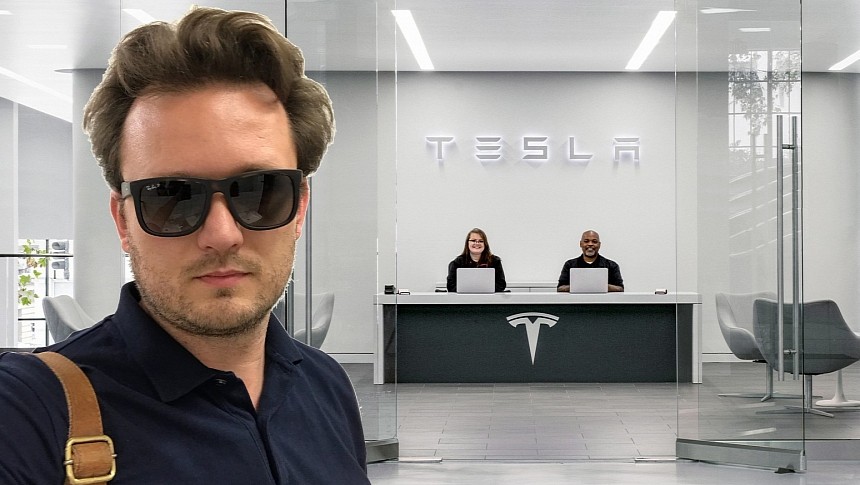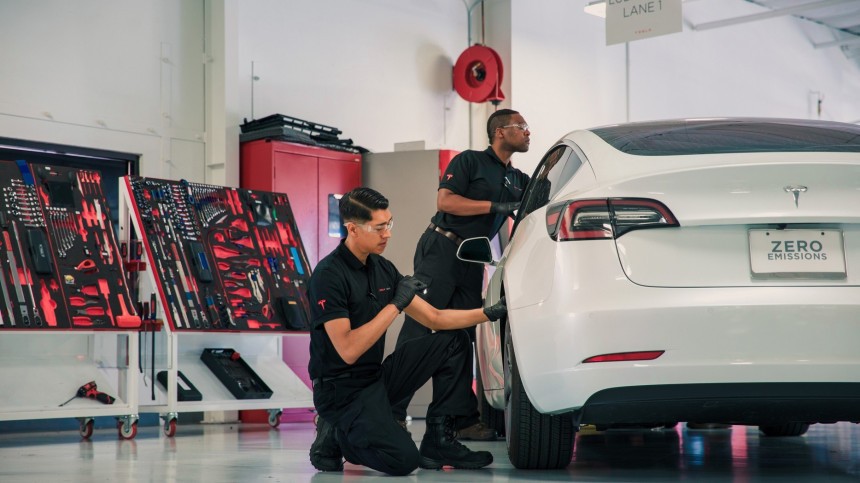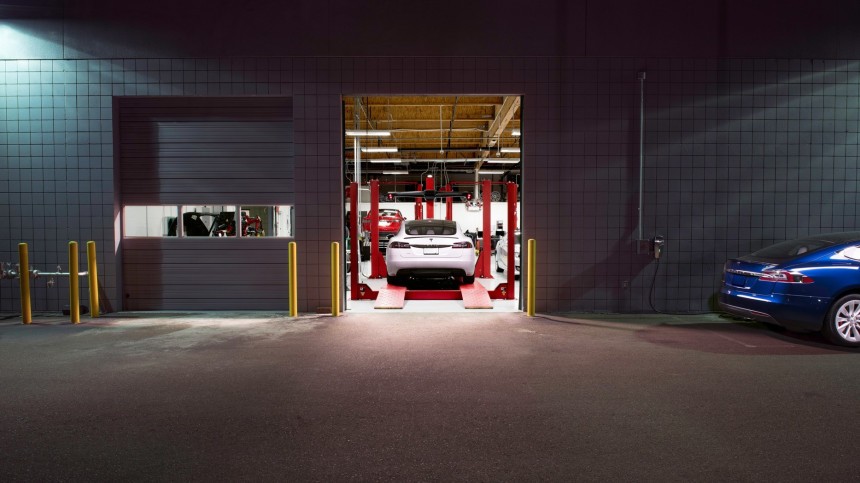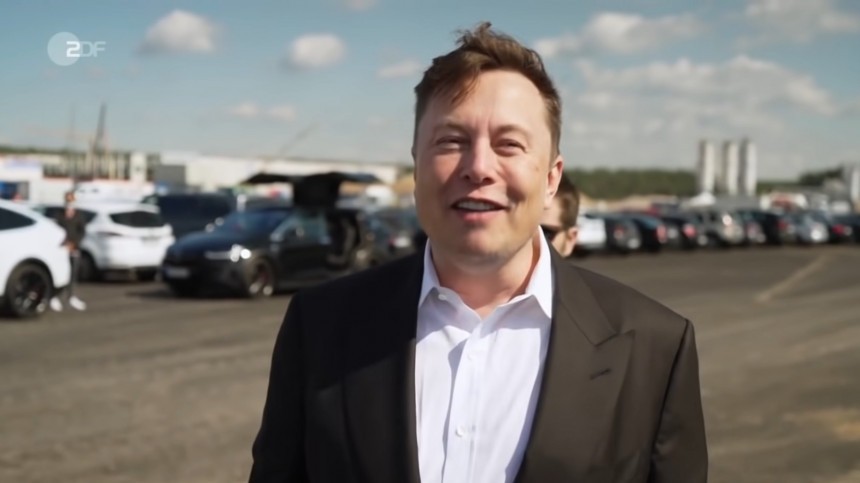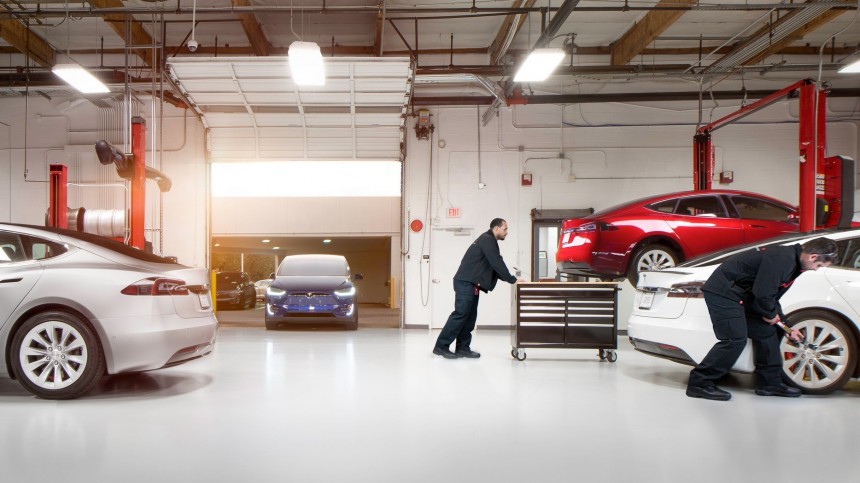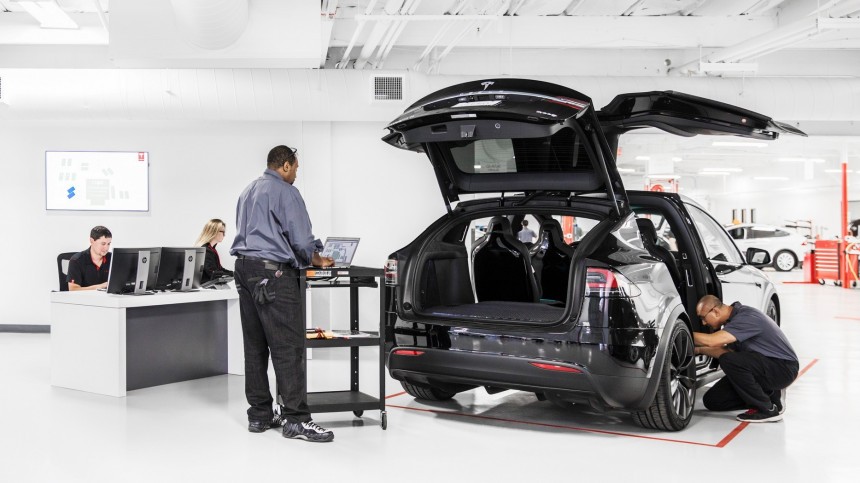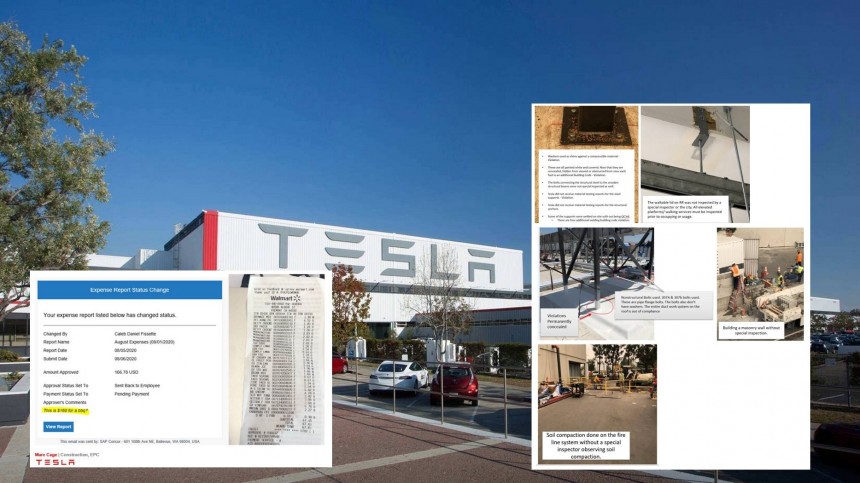The Tesla Files have revealed how poorly the battery electric vehicle maker protects its employees' and customers' personal data. It also showed how strategic files, such as those related to the Cybertruck development, were readily available to anyone in the company. What it had yet to reveal was the whistleblower's name and what led him to talk to Handelsblatt. Lukasz Krupski can now share with us how everything started.
The whistleblower was born in Warsaw but was a citizen of the world. He worked in Canada, Australia, the UK, Denmark and eventually went to Norway. This last move was explicitly to work for Tesla as a technician, a job he was hired for on October 2, 2018, and started a few weeks later, on November 1.
Money was not what drove Krupski to want this position. In fact, he would earn considerably less cash than he was already making – the equivalent of $55,000 a year. At Tesla, he would get NOK430,000 yearly, a sum that translated into $45,000 at the exchange rate of that time. According to the whistleblower, he was a "Tesla disciple," someone who wanted to help Elon Musk make the world better.
Right on his first day at work, Krupski noticed how poorly organized the business was. He was supposed to wear a work uniform, but Tesla did not have one for him. When he picked up his laptop, his colleagues said they only got theirs some months after they were hired. When he finally got his uniform, he would eventually go to work with different pants because the company did not wash these clothes: the employees had to take care of that. On March 30, 2019, Krupski would have other examples of that lack of organization. Ironically, that would also give him a chance to discuss them with the company's honcho – or Technoking, as he prefers.
Tesla had presented the Model 3 in Norway just a few days before that. Krupski worked for the Drammen Service Center, but the company organized a delivery event at Lillestrøm by renting a hall at the NOVA Spektrum expo center. The idea was to beat an old delivery record, so Tesla Norge (Norway) asked technicians from several service centers to come help in those efforts. Krupski and his colleagues had to replace the headlights in the first units because they did not comply with European regulations. None of the technicians had ever worked with the Model 3 or knew the NOVA Spektrum hall. Why Tesla did not install European headlights at the Fremont factory to ship them to Europe is a mystery. Apart from that, the technicians also had to replace the ICE computers because the E-Call was not working, a process that led to what happened next.
Krupski and his colleagues had to use 12V battery boosters in the computer replacement process so they would not brick. One of these lithium-ion boosters (a Rodac RABST12700) had a safety device removed from it that prevented the component from receiving energy back from the car. When the technicians were working on a blue unit, the battery pack started communicating with the replaced computer, the DC-to-DC converter powered on and started supporting the 12V battery. Inadvertently, it overcharged the booster, which exploded around noon.
Krupski removed the booster from the car, and his colleagues killed the fire by stamping on it with their boots. The problem is that some of the car components were already on fire, such as plastic pipes, containers, trim, and wiring harnesses. The molten plastic on fire was already dripping deeper into the car. The whistleblower removed them from the BEV and killed the fire with rags and towels. Summing up, he burned his hands in the process to prevent his employer from having its reputation charred. There were no fire extinguishers available. Having a brand-new car burn minutes before delivery would put the then-struggling company in even more trouble. The whistleblower – still on probation – was taken to the hospital by one of his colleagues.
Tesla's Norway manager witnessed everything, eventually praising Krupski's actions in an email message to Elon Musk on April 1. The Tesla CEO replied: "Thank you and congratulations for saving the day!" The whistleblower downplayed his own actions and said it was his duty to stop the fire before it got worse. Musk asked him: "Is there anything we can do to make things better in the future?"
The whistleblower replied on April 2, explaining what caused the fire to Musk. The Tesla CEO thanked him and asked if there was anything else to do. Krupski sent Musk a list of stuff that could be improved, including how the battery pack could be modified to be safer. On the same day, Tesla sent a message to all technicians ruling out that nobody should tamper with the company's tools. The whistleblower felt heard.
On April 6, Krupski sent another message to the Tesla CEO to tell him that a manager was insisting on checking his correspondence with Musk. To Dagens Næringsliv (DN), Krupski said he heard from his boss that his messages had caused trouble with the Technoking. The executive apparently forwarded the whistleblower's messages, and some of the people in Tesla Norway wanted Krupski to keep quiet. After everything that happened, it now seems that Musk was also annoyed by the whistleblower's messages.
The requests Krupski received from his direct management were against something the Tesla CEO had told all employees about communication. Musk wrote an email that is often praised as a display of his executive brightness. According to that message, hierarchy should be no barrier for employees to reach him. Those who didn't do that would even risk being fired for not letting him know about essential matters. What the whistleblower's manager wanted to do contradicted that guideline. Musk's answer did not seem to care about that. He replied: "I can't read emails unless they're critical to Tesla. It is literally physically impossible." How he can determine if a message is critical or not without reading it is a mystery.
For Krupski, that was a sudden twist. Something that Musk said was vital was not that important anymore. Honestly, it was equivalent to saying employees should keep their mouths shut about the issues presented by the company, especially if they did not want their direct supervisors and managers breathing down their necks. Krupski gave Musk the benefit of the doubt and interpreted that email as if local problems should have local solutions. That made him call a meeting on April 11 to discuss serious safety issues in his working environment. Several other technicians reinforced the same concerns. One of them was related to the Fetra battery tables used by the Drammen Service Center. They were used to remove the battery packs from the vehicles.
God knows why Tesla thought it was a good idea to use a table that could handle only 500 kilograms (1,102 pounds). The Model S's lightest battery pack at the time tipped the scale at 535 kg (1,149 lb), while the heaviest one did so at 625 kg (1,378 lb). On top of that, this table did not have a height adjustment. That meant the vehicle would have to be lowered to match the battery pack and not the other way around. That implies the table would eventually have to stand the weight of the entire vehicle, even with four men taking care of the whole operation.
Another dangerous situation was how some technicians removed suspension bolts with grinding disks. That damaged some vehicles, and the customers could see technicians doing that. They did not wear any personal protection equipment (PPE) in the process, which sent sparks all around the shop. One employee's shirt once caught fire. Krupski said his efforts to avoid that did not bring any changes. No issues or damages caused by these situations could be classified as work accidents: they were predictable and preventable, which was what the whistleblower and the colleagues who joined him were trying to do.
According to Handelsblatt, a manager said Krupski's suggestions would be taken seriously and handled professionally. The whistleblower realized what that meant when his computer got slower; he discovered that Code42 was running in the background.
This app promises to deal with "high-risk employees" who pose a threat to their employers. The whistleblower would eventually discover that Tesla bought around 31,000 licenses between November 2020 and May 2021. The company would have paid "only" $826,000 if it did not include support and 4,000 rebooked licenses, which led the bill to reach $1 million. One of these licenses was for Krupski, who would experience the effects of that surveillance a while later.
On April 23, the whistleblower's manager told him he probably did not have a future at Tesla anymore. Once, he asked Krupski to modify a tool, something the whistleblower had helped prevent at the company in his message exchange with Musk. The technician refused to do so, feeling that it was a trap. Handelsblatt tried to contact this manager but did not hear back from him. Krupski tried one last time to talk to Musk, but the Tesla CEO did not reply anymore. At the same time, the whistleblower was relocated to work in the basement of the Tesla Sales and Delivery Center, where he was in charge of problems with the vehicles' electronics. According to Krupski, that isolated him. He was no longer allowed to speak to his colleagues there, so he made a complaint to human resources (HR) on May 2.
While he intended to defend himself from what he considered discrimination, Krupski also wanted to discuss the "dangerous working conditions" he and his colleagues faced at the Tesla Service Center. He reported a toxic environment similar to that victims of sexual harassment shared they had to endure in the US.
On May 8, the whistleblower heard back from the HR department that the company considered firing him. His supervisor, who was also present at the meeting, said that Krupski spent too much time checking whether things were correct or not and interpreted them exaggeratedly and incorrectly. Considering the fire he helped extinguish and the battery table issue, that is very hard to believe. On top of that, we have heard the same story from other whistleblowers, such as Steven Henkes and Marc Cage.
That was just the start of several measures Tesla took against him. On September 23, 2020, he collapsed at work and had to go to the emergency room. That kicked off a sequence of sick leaves and psychotherapy. Sensing that he would soon be fired, Krupski started collecting evidence of how the company treated him. The whistleblower also got in touch with Aaron Greenspan, the publisher of PlainSite.
On November 2, 2021, Krupski was at home when he stumbled upon a dashboard from Tesla's finance department (Payables) on WARP – an in-house-built enterprise resource planning (ERP) system. He tried to open it and was surprised he could do so. Shortly after that, the whistleblower also checked Jira – the company's project management system – to test how much access he could have to more sensitive files despite being at the lower hierarchy ranks in the company. Krupski could even retrieve Elon Musk's expenses, his social security number, and how much his bodyguards cost. After being accused of "exaggeratedly and incorrectly" reporting the company's issues, he decided authorities should have a look at that. This is the origin of the Tesla Files. How they made it to Handelsblatt is also an interesting story that I'll tell you soon. Stay tuned.
Money was not what drove Krupski to want this position. In fact, he would earn considerably less cash than he was already making – the equivalent of $55,000 a year. At Tesla, he would get NOK430,000 yearly, a sum that translated into $45,000 at the exchange rate of that time. According to the whistleblower, he was a "Tesla disciple," someone who wanted to help Elon Musk make the world better.
Right on his first day at work, Krupski noticed how poorly organized the business was. He was supposed to wear a work uniform, but Tesla did not have one for him. When he picked up his laptop, his colleagues said they only got theirs some months after they were hired. When he finally got his uniform, he would eventually go to work with different pants because the company did not wash these clothes: the employees had to take care of that. On March 30, 2019, Krupski would have other examples of that lack of organization. Ironically, that would also give him a chance to discuss them with the company's honcho – or Technoking, as he prefers.
Krupski and his colleagues had to use 12V battery boosters in the computer replacement process so they would not brick. One of these lithium-ion boosters (a Rodac RABST12700) had a safety device removed from it that prevented the component from receiving energy back from the car. When the technicians were working on a blue unit, the battery pack started communicating with the replaced computer, the DC-to-DC converter powered on and started supporting the 12V battery. Inadvertently, it overcharged the booster, which exploded around noon.
Krupski removed the booster from the car, and his colleagues killed the fire by stamping on it with their boots. The problem is that some of the car components were already on fire, such as plastic pipes, containers, trim, and wiring harnesses. The molten plastic on fire was already dripping deeper into the car. The whistleblower removed them from the BEV and killed the fire with rags and towels. Summing up, he burned his hands in the process to prevent his employer from having its reputation charred. There were no fire extinguishers available. Having a brand-new car burn minutes before delivery would put the then-struggling company in even more trouble. The whistleblower – still on probation – was taken to the hospital by one of his colleagues.
The whistleblower replied on April 2, explaining what caused the fire to Musk. The Tesla CEO thanked him and asked if there was anything else to do. Krupski sent Musk a list of stuff that could be improved, including how the battery pack could be modified to be safer. On the same day, Tesla sent a message to all technicians ruling out that nobody should tamper with the company's tools. The whistleblower felt heard.
On April 6, Krupski sent another message to the Tesla CEO to tell him that a manager was insisting on checking his correspondence with Musk. To Dagens Næringsliv (DN), Krupski said he heard from his boss that his messages had caused trouble with the Technoking. The executive apparently forwarded the whistleblower's messages, and some of the people in Tesla Norway wanted Krupski to keep quiet. After everything that happened, it now seems that Musk was also annoyed by the whistleblower's messages.
For Krupski, that was a sudden twist. Something that Musk said was vital was not that important anymore. Honestly, it was equivalent to saying employees should keep their mouths shut about the issues presented by the company, especially if they did not want their direct supervisors and managers breathing down their necks. Krupski gave Musk the benefit of the doubt and interpreted that email as if local problems should have local solutions. That made him call a meeting on April 11 to discuss serious safety issues in his working environment. Several other technicians reinforced the same concerns. One of them was related to the Fetra battery tables used by the Drammen Service Center. They were used to remove the battery packs from the vehicles.
God knows why Tesla thought it was a good idea to use a table that could handle only 500 kilograms (1,102 pounds). The Model S's lightest battery pack at the time tipped the scale at 535 kg (1,149 lb), while the heaviest one did so at 625 kg (1,378 lb). On top of that, this table did not have a height adjustment. That meant the vehicle would have to be lowered to match the battery pack and not the other way around. That implies the table would eventually have to stand the weight of the entire vehicle, even with four men taking care of the whole operation.
According to Handelsblatt, a manager said Krupski's suggestions would be taken seriously and handled professionally. The whistleblower realized what that meant when his computer got slower; he discovered that Code42 was running in the background.
This app promises to deal with "high-risk employees" who pose a threat to their employers. The whistleblower would eventually discover that Tesla bought around 31,000 licenses between November 2020 and May 2021. The company would have paid "only" $826,000 if it did not include support and 4,000 rebooked licenses, which led the bill to reach $1 million. One of these licenses was for Krupski, who would experience the effects of that surveillance a while later.
While he intended to defend himself from what he considered discrimination, Krupski also wanted to discuss the "dangerous working conditions" he and his colleagues faced at the Tesla Service Center. He reported a toxic environment similar to that victims of sexual harassment shared they had to endure in the US.
On May 8, the whistleblower heard back from the HR department that the company considered firing him. His supervisor, who was also present at the meeting, said that Krupski spent too much time checking whether things were correct or not and interpreted them exaggeratedly and incorrectly. Considering the fire he helped extinguish and the battery table issue, that is very hard to believe. On top of that, we have heard the same story from other whistleblowers, such as Steven Henkes and Marc Cage.
On November 2, 2021, Krupski was at home when he stumbled upon a dashboard from Tesla's finance department (Payables) on WARP – an in-house-built enterprise resource planning (ERP) system. He tried to open it and was surprised he could do so. Shortly after that, the whistleblower also checked Jira – the company's project management system – to test how much access he could have to more sensitive files despite being at the lower hierarchy ranks in the company. Krupski could even retrieve Elon Musk's expenses, his social security number, and how much his bodyguards cost. After being accused of "exaggeratedly and incorrectly" reporting the company's issues, he decided authorities should have a look at that. This is the origin of the Tesla Files. How they made it to Handelsblatt is also an interesting story that I'll tell you soon. Stay tuned.
